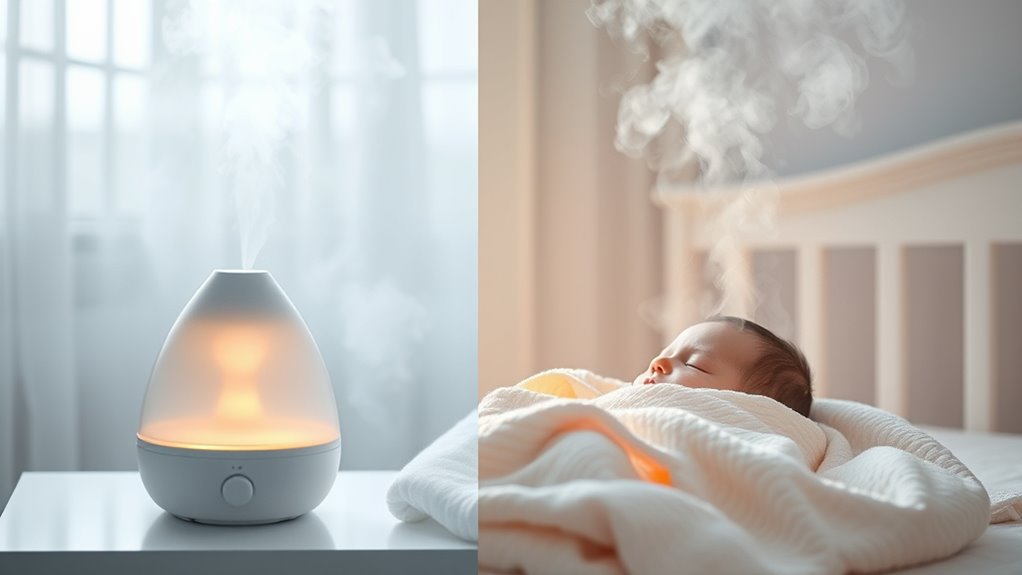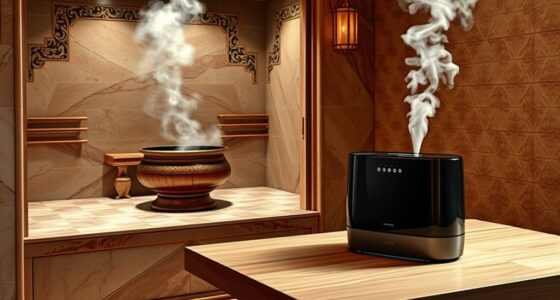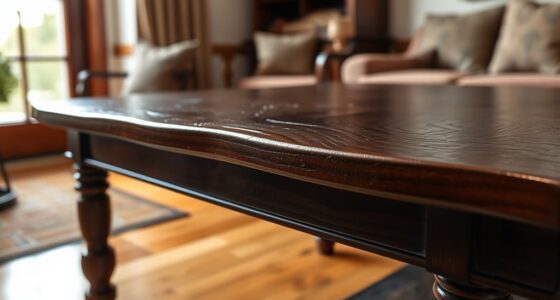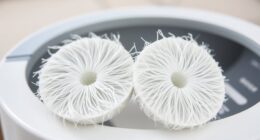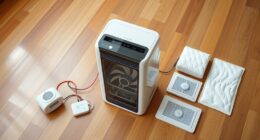When choosing between steam and cool mist humidifiers for your baby, consider safety and noise levels. Steam models kill germs but operate at high temperatures, posing a burn risk and being noisier, which might disturb sleep. Cool mist humidifiers are safer, quieter, and easier to maintain but need regular cleaning to prevent bacteria buildup. Both improve air quality, so understanding the differences can help you pick the best option—keep exploring to find out which suits your little one best.
Key Takeaways
- Cool mist humidifiers are quieter and safer, making them ideal for a baby’s sleep environment.
- Steam humidifiers reduce bacteria and mold through heating but pose burn risks and generate more noise.
- Both types require regular cleaning to prevent mold and bacteria buildup, ensuring safe air quality.
- Steam models improve air hygiene by killing pathogens but need careful handling due to high temperature.
- The choice depends on safety, noise sensitivity, and room environment, with cool mist generally recommended for babies.

A humidifier can be a valuable addition to your baby’s nursery, especially during dry months or when your little one is battling congestion. When choosing between steam and cool mist humidifiers, understanding their impact on air quality and noise levels can help you make the best decision for your baby’s comfort and safety. Both types add moisture to the air, but they do so differently, which can influence how your baby sleeps and breathes.
Steam humidifiers, also known as warm mist models, heat water before releasing it into the room as steam. This process can help eliminate bacteria and mold, potentially improving air quality. However, because they operate at high temperatures, they often generate more noise, especially when boiling water, which might disturb your baby’s sleep. The noise levels can be a concern if your little one is sensitive to sounds or if you prefer a quieter environment for napping. Additionally, the heat produced by steam humidifiers requires careful handling to prevent accidental burns, making them less ideal for nurseries with curious toddlers or infants who are starting to crawl.
Steam humidifiers heat water, eliminate bacteria, but can be noisy and pose burn risks.
On the other hand, cool mist humidifiers use a fan to disperse room-temperature or slightly cool water vapor into the air. They generally operate more quietly than steam models, making them a popular choice for nurseries where a peaceful sleep environment is essential. Because they don’t generate heat, they pose less risk of burns or fire hazards, which adds to their safety profile for homes with young children. When it comes to air quality, cool mist humidifiers can effectively increase moisture levels, helping to ease congestion and dry skin, but it’s important to clean them regularly to prevent mold and bacteria buildup, which could negatively impact air quality.
In terms of maintenance, steam humidifiers tend to be easier to clean since the heating process reduces bacteria, but they still require regular descaling. Cool mist models need diligent cleaning to prevent bacteria and mold growth, which can compromise air quality if neglected. Noise levels are typically lower with cool mist humidifiers, making them less disruptive during sleep times. If your priority is a quiet environment and safety, a cool mist humidifier is often the better choice. Yet, if you’re concerned about pathogen control and don’t mind a bit more noise, steam humidifiers can still be effective.
Furthermore, choosing a humidifier with proper filtration can significantly improve air quality and reduce the risk of airborne contaminants reaching your baby, ensuring a healthier environment.
Ultimately, your decision should consider your baby’s sensitivity, your room’s environment, and your comfort with noise and safety. Both types can improve air quality and help with congestion, but understanding their differences ensures you pick the right humidifier to keep your nursery safe, peaceful, and comfortable.
Frequently Asked Questions
Are Cool Mist Humidifiers More Energy-Efficient Than Steam Models?
You might wonder if cool mist humidifiers are more energy-efficient than steam models. Generally, cool mist units consume less energy because they don’t need to boil water, reducing both energy consumption and operational costs. Steam humidifiers use more power due to the heating process. So, if you’re looking to save on energy and keep operational costs low, cool mist humidifiers are usually the better choice.
How Often Should I Clean a Baby Humidifier to Prevent Mold?
You should clean your baby’s humidifier at least once a week to prevent mold buildup. Regular humidifier cleaning removes bacteria and mold spores, ensuring the air stays safe. If your baby has a cold or allergy, consider cleaning more often, maybe twice a week. Mold prevention relies on consistent maintenance, so don’t skip cleaning sessions. Keeping the humidifier dry and dry wiping after each use also helps keep mold at bay.
Can Humidifiers Help With Common Baby Cold Symptoms Effectively?
Humidifiers can be quite effective for cold symptom relief by adding moisture to the air, which helps soothe your baby’s irritated throat and nasal passages. This increased humidity may ease coughing and congestion, making your little one more comfortable. While they don’t cure colds, humidifier effectiveness in maintaining proper moisture levels can support your baby’s recovery and provide relief from common cold symptoms, especially during dry seasons.
Are There Specific Safety Features to Look for in Baby Humidifiers?
You might wonder if your baby’s humidifier has the right safety features. Look for an automatic shutoff; it turns the device off when water runs low, preventing overheating. A spill-proof design is also essential, reducing mess and risk of burns. These features help keep your little one safe and give you peace of mind, knowing the humidifier works effectively without hazards.
Do Humidifiers Affect the Air Quality in the Nursery Long-Term?
You might wonder if humidifiers impact your nursery’s air quality long-term. They can help reduce airborne pollutants like dust and allergens, creating a healthier environment. However, if not maintained properly, they can also breed mold or bacteria, potentially harming your baby’s long-term health. To keep the air clean, clean your humidifier regularly and use distilled water. This way, you support a safe, healthy space for your little one’s growth.
Conclusion
When it comes to your baby’s health, choosing between steam and cool mist humidifiers can feel like deciding between a superhero and a wizard—both mighty, but each with their own powers! But remember, the right humidifier can turn your little one’s room into a fortress of comfort, banishing dry air and sleepless nights forever. So pick wisely, because the future of your baby’s cozy, cough-free life depends on it—this isn’t just a choice, it’s a game-changer!
